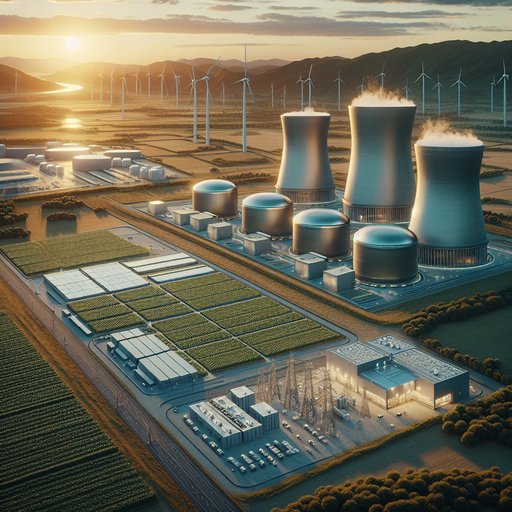
Small modular reactors (SMRs) and next‑generation nuclear technologies are moving from concept to concrete as countries seek firm, low‑carbon power that complements wind and solar. Their appeal is pragmatic: modular construction that aims to shorten schedules, designs that emphasize passive safety, and the ability to serve not only grids but also industry, heat networks, and remote communities. At the same time, developers and regulators are tackling long‑standing concerns about accidents and spent fuel by redesigning cores, fuels, and systems, and by advancing repositories. The result is a nuclear resurgence that is more flexible, more transparent, and better aligned with the demands of a modern, decarbonized energy system.
Reliable, low‑carbon electricity is a cornerstone of climate strategies, yet many regions face rising variability as renewables scale and fossil plants retire. SMRs address this challenge by providing dispatchable capacity in smaller increments, easing financing and grid integration while maintaining a small land footprint. Their ability to load‑follow and co‑locate with industrial facilities helps decarbonize sectors that are hard to electrify with intermittent resources alone. In energy systems strained by extreme weather and geopolitical shocks, firm nuclear power that can be deployed where and when it is needed is a valuable tool.
SMRs are typically defined as reactors producing up to a few hundred megawatts of electricity, with modules that can be factory‑fabricated and shipped to site. Standardized designs like GE Hitachi’s BWRX‑300, NuScale’s integral pressurized water reactor, and Rolls‑Royce’s UK SMR aim to reduce complexity and realize learning‑curve cost reductions across fleets. The same modularity supports non‑electric uses: district heating, desalination, and hydrogen production, particularly for high‑temperature concepts. By right‑sizing units to local demand and existing grid connections, SMRs can reutilize brownfield sites and accelerate deployment schedules.
Modern safety philosophies are embedded from the outset. Many light‑water SMRs place the reactor core, steam generators, and pumps within a single vessel and use natural circulation, gravity‑fed water, and passive heat removal to manage accidents without power or operator action for extended periods. Designs such as NuScale’s place modules in a below‑grade pool, enhancing protection from external hazards, while the BWRX‑300 simplifies systems and leverages proven passive features from earlier certified designs. Lower operating pressures, smaller core inventories, and simplified piping reduce the likelihood and potential consequences of large releases.
These engineered features are complemented by probabilistic risk assessment and severe accident management plans that reflect lessons learned since the 1970s and 1980s. Beyond light‑water SMRs, next‑generation reactors pursue different physics to strengthen safety and broaden applications. High‑temperature gas‑cooled reactors such as X‑energy’s Xe‑100 use TRISO fuel—ceramic‑coated particles that retain fission products at very high temperatures—and operate at low pressure, providing stable, high‑quality heat for industry. Molten salt concepts keep fuel in liquid form at near‑atmospheric pressure and include passive drain tanks to move hot salt to safe, subcritical storage if temperatures rise.
Sodium‑cooled fast reactors like TerraPower’s Natrium pair a fast‑spectrum core with molten‑salt thermal storage, enabling rapid power swings to balance renewables. Each approach introduces distinct hazards—sodium reacts with water, for example—but developers address them through inert cover gases, leak detection, and segregated systems proven in prior test programs. Waste management is evolving alongside reactor design. All reactors produce spent fuel, but advanced fuel forms can improve containment of radionuclides, and fast‑spectrum reactors can fission transuranic elements that dominate long‑term radiotoxicity.
Even with these advances, deep geological disposal remains essential, and it is moving from theory to practice: Finland’s Onkalo repository has regulatory approvals and construction underway, and Sweden has authorized a repository at Forsmark. Countries continue to use robust dry cask storage for decades of safe interim management while repositories are completed. In parallel, some nations pursue recycling to reduce volume and recover energy, while others focus on once‑through fuel cycles to minimize proliferation risks. Fuel supply and safeguards shape the pace of deployment.
Many advanced designs use high‑assay low‑enriched uranium (HALEU), which is more efficient but requires dedicated enrichment capacity and rigorous material control; the United States took a first step when Centrus began producing initial quantities in 2023 under a Department of Energy program. More, and diversified, HALEU supply will be needed to support multiple vendor fleets, alongside international safeguards tailored to new fuel forms. A larger number of smaller sites will necessitate strong security culture, remote monitoring, and standardized physical protection. Regulators and industry are coordinating across borders—through initiatives such as the IAEA’s Nuclear Harmonization and Standardization Initiative and bilateral collaborations—to align requirements without diluting safety.
Economics remain the decisive hurdle, and recent experience provides both caution and direction. First‑of‑a‑kind projects carry schedule and cost risk; in 2023, the NuScale‑UAMPS project in the United States was canceled after projected costs rose, underscoring the need for realistic budgets and firm supply chains. Other pathways emphasize mature technologies and fleet effects: Ontario Power Generation is advancing a BWRX‑300 at Darlington with plans for replication, and partnerships in Poland are preparing for multiple units of the same design. In the United Kingdom, the Rolls‑Royce SMR is progressing through the generic design assessment, while in the United States, the DOE’s Advanced Reactor Demonstration Program supports TerraPower and X‑energy in first deployments.
Repowering retiring coal sites, reusing skilled workforces and grid hookups, and co‑optimizing with renewables and storage can further improve project economics. Public confidence hinges on transparent performance—on‑time, on‑budget builds and clear safety cases that withstand independent scrutiny. Demonstrators must show that passive systems behave as designed, that operations can load‑follow variable renewables without undue wear, and that emergency planning can be right‑sized to actual risk. Parallel progress on consent‑based siting for waste facilities, as seen in the Nordic countries, will help close the fuel‑cycle loop in practice rather than on paper.
Tangible success at a handful of sites can unlock financing and lower perceived risk for the next wave. The promise of SMRs and next‑generation nuclear is pragmatic rather than utopian: safer designs that simplify operations, flexible output that stabilizes clean grids, and credible solutions for spent fuel anchored in real projects. Delivering that promise will require standardized designs, qualified supply chains, domestic fuel capability for advanced reactors, and regulatory collaboration that maintains rigor while enabling innovation. If the early projects of this decade achieve their milestones, they can establish nuclear power as a reliable partner to renewables in the push to net‑zero.
That, more than any slogan, is how modern nuclear addresses safety and waste concerns and earns its place in the energy transition.












































